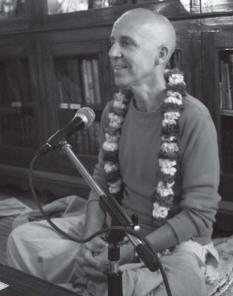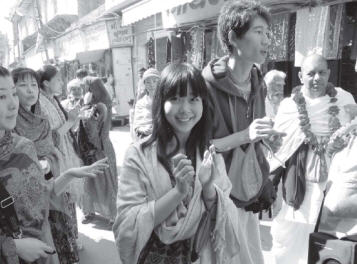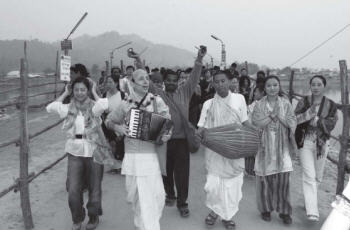Spiritual tours in India are transforming international yoga practitioners.

In my backpacker days as a youth I hitchhiked in Europe, North and South America, Asia and Australia. This was after my studies and the compulsory military service. Naturally I enjoyed my new freedom. But sometimes I questioned the value of what I was doing in traveling to scenic places because I knew I could never stay there. The Bhagavad-gita (5.22) explains that a person who does not delight in pleasures that have a beginning and an end is considered to be wise. Longing for temporary pleasures results in disappointment; what is the use of journeying to a beautiful place, becoming attached to it, and then having to suffer the letdown of having to leave it? In due course I realized that life offered a chance to achieve lasting pleasure through spiritual practice.
Now, for the last several years, I’ve been guiding hatha-yoga practitioners from Asia on tours to holy places in India. I love to do this, because it is different from ordinary sightseeing. Everyone who participates in the tour is uplifted. What they experience is spiritual and therefore remains an asset that does not decrease (pratyavayo na vidyate; Bg. 2.40). Whenever I meet any former tour-members, they substantiate how the experience has deeply impacted their lives.
During our ten-day-long pilgrimage, we first visit the Himalayan Mountain resorts of Rsikesa, Haridvar and Devaprayag. The second portion is spent in Vrndavana, located on the banks of the holy River Yamuna, about three hours south-east from New Delhi.
There are many people who visit holy places in India but often they recall incidents of excessive noise, sights of garbage litter, the extreme poverty, or hassles with local vendors or rickshaw drivers instead of something spiritually elating. Why precisely is our tour to holy places a spiritual uplifting experience? It is because we expose our guests to ample contact with eternal reality. To find out what on a deeper level takes place on such a tour, I shall explain how yoga teachings define reality, how the visitors spend their time, and the realizations they gain. From this the reader should be able to comprehend how our yoga pilgrimage results in an enriching spiritual experience. But ultimately the proof of the pudding is in the eating.
Defining Reality

How we define reality decides our worldview and moulds our life. No wonder that serious discussions about the question, “What is the Absolute Truth/reality?” are often avoided. But in fact, philosophical discussions enrich the quality of our lives.
Surprisingly perhaps, it is almost impossible not to believe in an Absolute Truth/reality. For example, a materialist considers that the totality of matter is the Absolute. The word absolute means “the complete, the independent,” and is derived from the Latin word absolvere (to free, to complete) and absolutum (unbound, independent). Relative means “in relation to” and is derived from referre (to bring back, to relate, and to put in reference). A materialist explains reality in relation to matter.
The issue therefore is not whether there is an Absolute but what I consider as the Absolute. Yoga philosophy says consciousness is independent from matter and matter is dependent on consciousness. This idea is essentially theistic, but unlike monotheists with their exclusive version of truth (often a relative idea of God), yoga-theists conceptually accept the existence of an Absolute Truth (self-sufficient, independent). Someone who practices yoga comes to realize that the Absolute includes features of eternal individuality.
Yoga teaches that the absolute and the relative belong together as a harmonious unit, because the absolute contains the relative (oà purnaà). Truth is without duality, is undivided being, which is the literal meaning of the word indivi-dual [from Latin dividere (to divide) and in (negating)]. Although we as individuals are part and parcel of the Absolute Individual in that sense relative and dependent we are united (yoga) with the Absolute via love and devotion (Bg. 4.35, 15.7). Thus we experience full independence eternally as individuals. Eternally because truth transcends space and time.
The present experience of disunity (viyoga or ayoga) is not caused by a competitor of the Absolute: the Absolute has no counter pole (Satan). Figuratively speaking, light is all-pervading. Darkness has no independent existence from light; but light is not the cause of darkness; rather darkness is caused by disunity. We individuals have the choice to turn away from light and are thus subjected to darkness. Relative truth (darkness) is our own choice/creation. We individuals can turn our attention away from darkness to light and thereby experience rasa (feelings, love) even while residing in the phenomenal, relative world. Thus one relishes the good fortune of devotional activities that transform dull material existence to a dimension of loving exchanges.
The Taittiriya Upanisad (2.7.1) states, raso vai sah: the Absolute Truth is the reservoir of reciprocal loving exchanges. Essentially it is hinted here that our natural longing for beauty, power, wealth, knowledge, renunciation, and fame should be directed to reality (light), where these qualities are found and are fully satisfying, beyond what we can imagine. The principle of eternal individuality, however, needs to be acknowledged to make way for a blissful result of yoga practice. Therefore, it cannot be maintained that reality is only matter, nor that only the Absolute (Brahman) devoid of eternal individuality (atma and isvara) exists. Personhood and feelings are characteristics of theistic philosophy.
Of interest perhaps is the question, “Does a person possess the capacity to recognize and unify with the Absolute?” Reality would have no real meaning if we would not be able to experience it. Atheists say that there is no absolute (by the way, an absolute statement) or that we do not have the capacity to know it. Some religious people (monotheists) say that we once had this capacity but lost it because of “sin” and can only know the truth by revelation provided of course one accepts their particular version of salvation. The yoga traditions explain that the Absolute is all-powerful, all-inclusive (because it includes the relative), and is therefore accessible to all and not merely through one channel or at one point in time.

Out of His mercy the Absolute manifests in the relative world. Our yoga-pilgrims link up with such manifestations of the Absolute by taking a dip in holy rivers, chanting mantras, residing in holy places, participating in worship ceremonies (puja), hearing of lilas (divine pastimes), and reciting sastra (Sanskrit texts). Moreover, there is eating of prasada (sanctified foods), singing and dancing to sacred music, holy festivals simple and joyful methods of meditation on the Absolute that anyone can partake. The participants of our tours attend the regular temple morning program before sunrise: mangala-arati, mantra meditation and morning lectures. During the day, instead of shopping in the markets, they join the harinama party. The local vendors respond with joyful gestures to the singing and dancing of the elated foreign guests, making them feel welcome as well as foreseeing that they will return to spend their money.
Towards the end of the tour the participants express their realizations: “I did not know that life could be so pleasurable,” or “I found what I was always looking for,” or “My life will not be the same again.” That is the effect of wholeheartedly participating in
spiritual activities, even if only for ten days. Contaminated consciousness is purified by the touch of the Absolute and awareness, formerly restricted to the relative platform, is elevated. Pilgrims feel enriched beyond anything they have ever experienced. And, anyone wishing to further solidify and even boost the experience can continue the learned practices, regardless of the particular place they return to.
Sankirtana Dasa is a bhakti-sastri teacher. He works with a travel agent in Beijing to take yoga students to Rsikesa, VRndavana and other holy places in India. He is the author of Bhakti Yoga Pilgrimage. http://www.vedamsbooks.com/no60487.htm. Contact: Sankirtana.lok@pamho.net
